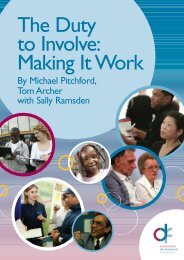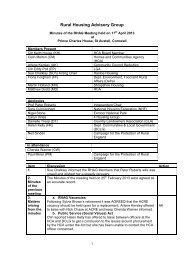Rapid Evidence Assessment of the Research ... - Rural Housing
Rapid Evidence Assessment of the Research ... - Rural Housing
Rapid Evidence Assessment of the Research ... - Rural Housing
Create successful ePaper yourself
Turn your PDF publications into a flip-book with our unique Google optimized e-Paper software.
What are <strong>the</strong> social and economic impacts <strong>of</strong> households owning second homes?<br />
194. In <strong>the</strong> 1970s as Gallent et al (2005) note, <strong>the</strong>re was some interest in <strong>the</strong> impact <strong>of</strong> property speculation in<br />
<strong>the</strong> second home market. It was frequently commented in <strong>the</strong> media that derelict/unimproved properties were<br />
purchased in rural areas and that <strong>the</strong>y were modernised using house improvement grants. The property would<br />
<strong>the</strong>n be sold on with a substantial pr<strong>of</strong>it. This practice was ended through <strong>the</strong> <strong>Housing</strong> Act, 1974. However,<br />
anti-second home commentators such as Monbiot (2006) and He<strong>the</strong>rington (2006) continue to assert <strong>the</strong><br />
significance <strong>of</strong> property speculation. Indeed, surveys <strong>of</strong> <strong>the</strong> reasons why households purchase second homes<br />
support this view. The Government’s Survey <strong>of</strong> English <strong>Housing</strong> has consistently shown that 25 to 40 per cent<br />
<strong>of</strong> owners regard a second home as an investment.<br />
195. Gallent et al (2005) comment that many studies suggest that a positive benefit <strong>of</strong> second home<br />
ownership is that it leads to an overall improvement <strong>of</strong> <strong>the</strong> quality <strong>of</strong> <strong>the</strong> housing stock.<br />
196. Finally, <strong>the</strong>re is <strong>the</strong> impact <strong>of</strong> second homes on <strong>the</strong> broader rural economy. Again, while <strong>the</strong>re is<br />
considerable discussion on this topic, <strong>the</strong>re is relatively little if any recent research in England. Reviews <strong>of</strong> earlier<br />
studies by, for example, Gallent et al (2005) and Wallace et al (2005) suggest <strong>the</strong> following interrelated points:<br />
• Second homes as part <strong>of</strong> <strong>the</strong> wider tourist economy that benefits rural areas. Indeed some commentators<br />
have hinted that second homes may be a s<strong>of</strong>ter and more appropriate form <strong>of</strong> tourism because <strong>of</strong><br />
potentially greater spending in <strong>the</strong> local economy (than, say, day visitors).<br />
• Debate and discussion on whe<strong>the</strong>r second home owners increase expenditure on local goods and<br />
services. There are different schools <strong>of</strong> thought on this from studies in <strong>the</strong> 1970s. Some researchers (for<br />
example, Downing & Dower, 1973) suggested that <strong>the</strong>re is ‘an annual permanence to <strong>the</strong> inflows <strong>of</strong><br />
expenditure’. But Jacobs (1972) concluded that many second home owners were self sufficient and<br />
contributed very little to <strong>the</strong> village economy.<br />
• Balancing second home expenditure. Shucksmith (1981) noted that in reaching a robust conclusion on this<br />
issue required that <strong>the</strong> increased expenditure by second home owners needed to be compared with <strong>the</strong><br />
loss <strong>of</strong> expenditure from local residents that were unable to afford to live in villages. However, no recent<br />
study in England has adopted this type <strong>of</strong> approach.<br />
197. Gallent et al (2005) also note that an economic assessment should take account <strong>of</strong> <strong>the</strong> Council Tax<br />
contribution. This has been <strong>the</strong> subject <strong>of</strong> considerable media attention over <strong>the</strong> last few years (see<br />
He<strong>the</strong>rington, 2006) as well as studies by <strong>the</strong> Commission for <strong>Rural</strong> Communities (2006) and Oxley and Brown<br />
(2006). The reduction <strong>of</strong> Council Tax discount and <strong>the</strong> use <strong>of</strong> <strong>the</strong>se resources to provide or facilitate affordable<br />
housing are covered in <strong>the</strong>se studies. Commentators have, however, noted that this policy initiative does not<br />
address <strong>the</strong> underlying issue <strong>of</strong> whe<strong>the</strong>r second home ownership should be curtailed in some areas because <strong>of</strong><br />
<strong>the</strong>ir social and economic impact.<br />
Environmental impacts<br />
198. Although <strong>the</strong> brief for this paper did not explicitly extend to environmental impact, most frameworks for<br />
investigating second homes stress <strong>the</strong> significance <strong>of</strong> this issue. Fur<strong>the</strong>rmore, <strong>the</strong>re is considerable overlap<br />
between environmental and socio-economic impacts. Never<strong>the</strong>less most reviews <strong>of</strong> second home research<br />
note that <strong>the</strong>re has been little robust research in recent years on this aspect, especially in England.<br />
199.<br />
The key considerations are:<br />
• Resource usage: Downing and Dower (1973) pointed out that second home households increase resource<br />
consumption and have negative impacts on <strong>the</strong> environment. This is clearly now a topic that is worth<br />
fur<strong>the</strong>r investigation.<br />
51






